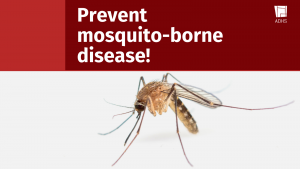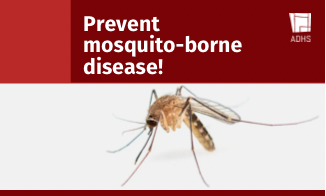 Spring brings with it many beautiful things. Wildflowers. Blooms on saguaro cactus. Warmer weather in mountainous areas that have been cold and snowy during the winter.
Spring brings with it many beautiful things. Wildflowers. Blooms on saguaro cactus. Warmer weather in mountainous areas that have been cold and snowy during the winter.
Spring and summer also give rise to mosquitoes. That calls for some care when you get out to enjoy the flowers and great weather, and when you tend to your yard.
Mosquitoes – most prevalent in Arizona between March and October – often carry disease, including the potentially deadly West Nile virus. Last year, Arizona saw a record-breaking season with 1,693 human cases of West Nile Virus, including 121 fatalities.
There is no human vaccine for West Nile virus, and there are no specific treatments. The best way to prevent West Nile virus is to avoid mosquito bites by following these steps:
- When outdoors, apply an insect repellent approved by the EPA by following the label instructions.
- Apply repellent especially at dawn and dusk as well as during the daytime or wear long sleeves and trousers.
- Make sure screens are used and intact to keep mosquitoes out if doors or windows are open.
- Dump or treat all standing water near and inside your home, where mosquitoes can breed.
While anyone can contract West Nile virus and other mosquito-borne diseases, the average age of those with West Nile Virus was 66. In 2021, 985 men and 708 women became ill with the disease.
Most people infected with West Nile virus have no symptoms or only mild illness. Most who have symptoms will experience flu-like illness, including fever, headache, body aches, swollen glands, and muscle weakness. Symptoms usually last for a few days or weeks, but sometimes there can be longer lasting health effects. West Nile virus can also cause more serious conditions including encephalitis (an inflammation of the brain) and meningitis (an inflammation of the linings of the brain and spinal cord).
West Nile virus is a fairly new disease and was first detected in Arizona in 2003, just four years after it was identified in the U.S.
Mosquito surveillance by local vector control agencies and by ADHS involves trapping mosquitoes, counting them, identifying the species, and testing the mosquitoes for viruses. Health officials and vector control professionals put out tens of thousands of traps and identify hundreds of thousands of mosquitoes. Knowing which mosquitoes are active in different parts of the state helps public health officials identify areas at higher risk for mosquito-borne diseases and target control efforts.
In 2021, about 58,000 traps set out for the season collected 34,000 mosquito pools, which are groups of mosquitoes that were tested.










